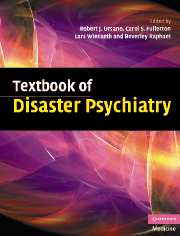Book contents
- Frontmatter
- Contents
- List of contributors
- Preface
- Part I Introduction
- Part II Foundations of disaster psychiatry
- Part III Clinical care and interventions
- 6 Early intervention for trauma-related problems following mass trauma
- 7 Acute stress disorder and post-traumatic stress disorder in the disaster environment
- 8 Assessment and management of medical-surgical disaster casualties
- 9 Interventions for acutely injured survivors of individual and mass trauma
- 10 Nongovernmental organizations and the role of the mental health professional
- Part IV Special topics
- Part V Public health and disaster psychiatry
- Index
- References
9 - Interventions for acutely injured survivors of individual and mass trauma
from Part III - Clinical care and interventions
Published online by Cambridge University Press: 09 August 2009
- Frontmatter
- Contents
- List of contributors
- Preface
- Part I Introduction
- Part II Foundations of disaster psychiatry
- Part III Clinical care and interventions
- 6 Early intervention for trauma-related problems following mass trauma
- 7 Acute stress disorder and post-traumatic stress disorder in the disaster environment
- 8 Assessment and management of medical-surgical disaster casualties
- 9 Interventions for acutely injured survivors of individual and mass trauma
- 10 Nongovernmental organizations and the role of the mental health professional
- Part IV Special topics
- Part V Public health and disaster psychiatry
- Index
- References
Summary
Introduction
Natural and human-made disasters entail the threat of physical injury. Injured trauma survivors initially receive care in the acute care medical setting. For example, the Centers for Disease Control report that within 48 h after the September 11, 2001 attack on the World Trade Center, 1 103 physically injured survivors were triaged through five acute care facilities in New York (Centers for Disease Control and Prevention, 2002). Injured survivors of mass disasters have been identified as a high-risk group that may require specialized early screening and evaluation procedures (United States Department of Defense et al., 2001; United States Department of Health and Human Services, 2003).
Trauma exposure when coupled with physical injury confers a higher risk for the development of post-traumatic stress disorder (PTSD) (Abenhaim et al., 1992; Green, 1993; Helzer et al., 1987; Hoge et al., 2004; Koren et al., 2005). Between 10% and 40% of hospitalized adolescent and adult injury survivors in the United States may go on to develop symptoms consistent with a diagnosis of PTSD (Holbrook et al., 2001; Marshall & Schell, 2002; Michaels et al., 1999b; Ursano et al., 1999; Zatzick et al., 2002a, 2002b, 2004c, 2006). Among injury survivors, PTSD is often complicated by comorbid, depressive symptoms (O'Donnell et al., 2004; Shalev et al., 1998b; Zatzick et al., 2004c, 2006) and medically unexplained somatic complaints (Engel et al., 2000; Katon et al., 2001b; Zatzick et al., 2003).
Keywords
- Type
- Chapter
- Information
- Textbook of Disaster Psychiatry , pp. 190 - 205Publisher: Cambridge University PressPrint publication year: 2007
References
- 3
- Cited by



